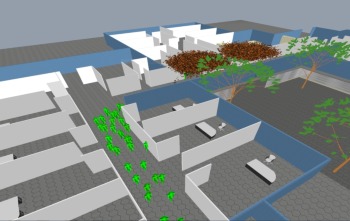Improved Planning for the Evacuation of Buildings

Crowd Control can determine in advance how thousands of people will move, and it does so at a rate that is ten times faster than real life. This improves the planning of buildings and allows security personnel to be trained more easily. Siemens offers building evacuation simulations as an independent consulting service. This service encompasses the entire range of analytical tasks, extending from data collection and data preparation to the generation of reports and the interpretation of the results.
One of the reasons why it is so difficult to plan building evacuations in advance is that conditions change very quickly and dynamically during emergencies such as fires or shootings. In addition, it's hard to estimate how many people are actually present at an event and whether any of them fall into special categories (e.g. elderly, children, disabled). Moreover, passages can be blocked by objects and temporary construction sites can prevent people from using emergency exits.
The consultants from Siemens work together with the customers and their architects and planners to develop a variety of scenarios, for which they then use Crowd Control to calculate and visualize the resulting effects. Among other things, experts can take different types of people and blocked passages into account.
The algorithm, which was developed by Siemens' global research unit Corporate Technology, divides spaces into small virtual cells, each of which corresponds approximately to the space needed by a single human being. Force fields are used to define the behavior of empty and occupied cells.
Users can select person' starting points and destinations. Once the parameters are set, the model can run an emergency scenario that enables it to predict where dangerous situations would arise in the event of an evacuation under the postulated conditions.
Buildings can be made safer and before construction
Because the results can be viewed in 3D and in real time, the software can also be used as a training tool for demonstrating a variety of scenarios to security personnel. The consultants from Siemens also assist architects and security officers by using Crowd Control to analyze building plans. As a result, buildings can be made safer and more cost efficient before they are actually constructed.
Possible areas of application include airports, train stations, schools, shopping centers, and office buildings. In the case of airports and train stations in particular, simulations are the only feasible means of determining whether existing plans will be effective in an emergency. The experts from Siemens plan to further enhance Crowd Control in the future so that it can simulate other highly complex scenarios such as floods and explosions.
Media Contact
All latest news from the category: Information Technology
Here you can find a summary of innovations in the fields of information and data processing and up-to-date developments on IT equipment and hardware.
This area covers topics such as IT services, IT architectures, IT management and telecommunications.
Newest articles

Properties of new materials for microchips
… can now be measured well. Reseachers of Delft University of Technology demonstrated measuring performance properties of ultrathin silicon membranes. Making ever smaller and more powerful chips requires new ultrathin…

Floating solar’s potential
… to support sustainable development by addressing climate, water, and energy goals holistically. A new study published this week in Nature Energy raises the potential for floating solar photovoltaics (FPV)…

Skyrmions move at record speeds
… a step towards the computing of the future. An international research team led by scientists from the CNRS1 has discovered that the magnetic nanobubbles2 known as skyrmions can be…





















